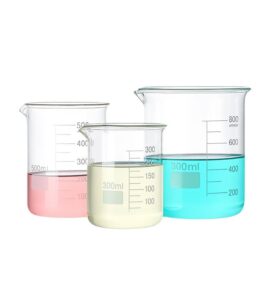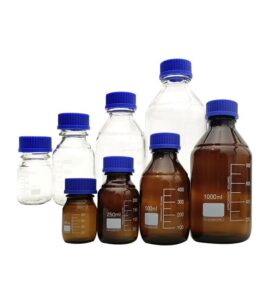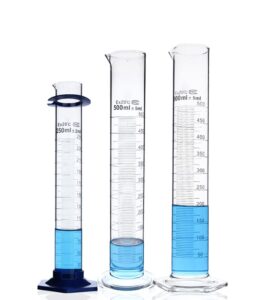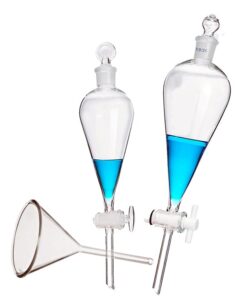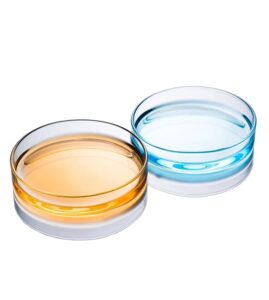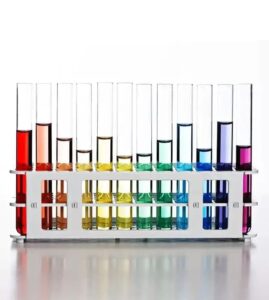Have you ever wondered how a simple laboratory flask could revolutionize your scientific experiments? What if there was a way to transform mundane lab practices into a hub of innovation, yielding brilliant results? Picture a world where each flask becomes a key player in groundbreaking discoveries.
The Ultimate Flask Guide offers just that – a fresh perspective on using laboratory flasks to maximize efficiency and accuracy in scientific research. This guide not only provides practical tips but also delves into innovative techniques that can elevate your lab work to new heights.
Stay with us as we embark on this enlightening journey!

Why Are Flasks Essential in Laboratory Work?
Flasks are far more than just vessels for holding substances; they are foundational tools in scientific experiments, playing a multitude of critical roles. Their importance in a laboratory setting can be highlighted through several key aspects:
- Accuracy: They are designed for precise measurements, especially volumetric flasks, ensuring exact solution concentrations.
- Safety: Their shapes, like the narrow neck of an Erlenmeyer flask, reduce spill risks, particularly with volatile or hazardous chemicals.
- Versatility: Different flasks serve varied purposes, from evenly heating liquids in round-bottom flasks to allowing easy mixing in Erlenmeyer flasks.
- Durability: Made from materials like borosilicate glass, flasks withstand high temperatures and chemical corrosion.
- Compatibility with Equipment: Flasks fit well with modern lab equipment like stirrers and heating mantles, making them adaptable for diverse experiments.
Laboratory flasks are indispensable due to their accuracy, safety, versatility, and fundamental role in experimental design. Understanding and utilizing the full potential of different types of flasks can significantly enhance the precision, safety, and efficiency of laboratory work.
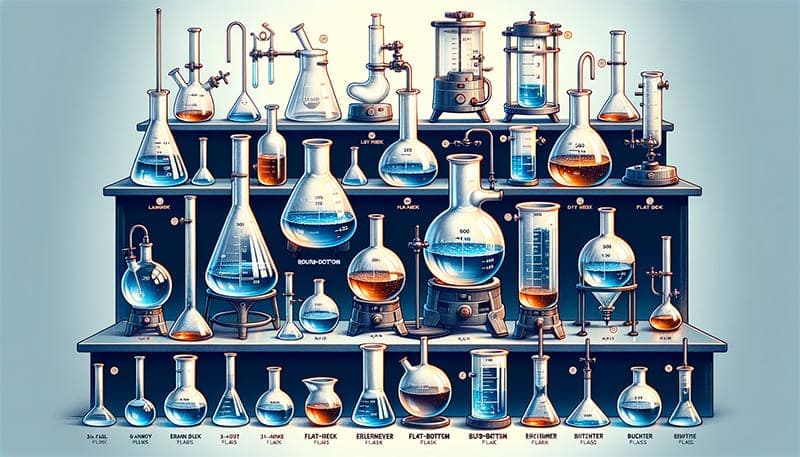
Types of Heat-Resistant Flasks in the Laboratory
In laboratory settings, the choice of flask is critical for safe and effective heating during experiments. Here is a detailed table outlining various types of heat-resistant flasks, their unique features, common applications, and images for reference:
| Flask Type | Image | Features | Common Applications |
|---|---|---|---|
| Round-Bottom Flask | 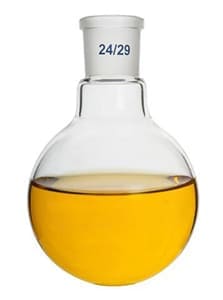 | Spherical shape, evenly distributes heat; available in various sizes; often has a single neck, but can have multiple. | Widely used in heating liquids, distillation, and reflux processes due to its ability to evenly distribute heat. |
| Three-Neck Flask | 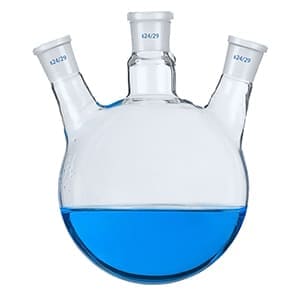 | Multiple necks for adding or removing substances; can be fitted with stoppers or additional apparatus. | Ideal for complex chemical reactions where simultaneous addition, removal, or monitoring is needed. |
| Flat-Bottom Flask | 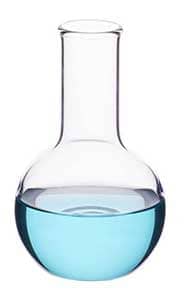 | Flat base suitable for standing on flat surfaces; more stable than round-bottom flasks. | Perfect for reactions that require direct heating on hot plates or other flat surfaces. |
| Erlenmeyer Flask | 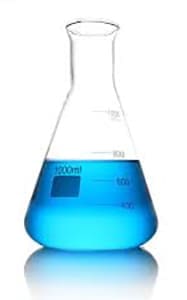 | Conical shape, wide base narrowing to a narrow neck; marked for approximate volume measurements. | Commonly used for mixing by swirling, titrations, and can be heated gently; its shape minimizes spillage. |
| Büchner Flask | 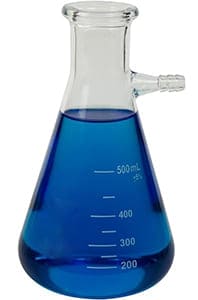 | Heavy-walled, designed to withstand vacuum pressure; side arm to connect to vacuum source. | Primarily used in vacuum filtration, often paired with a Büchner funnel for filtering suspensions. |
| Distillation Flask | 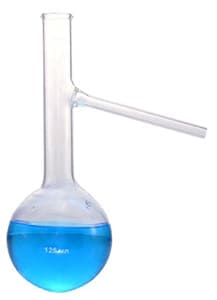 | Specific shapes like pear-shaped or round-bottom; often with a side-arm. | Specifically used in distillation processes to separate liquids based on boiling point differences. |
Each of these flasks is designed with specific features that make them suitable for a range of applications in the laboratory. Understanding their characteristics helps scientists and researchers select the appropriate flask for their particular heating needs, ensuring both safety and efficiency in their experimental procedures.
These heat-resistant flasks are indispensable tools in the lab, each uniquely contributing to various scientific processes. Their proper use not only facilitates successful experiments but also ensures the safety of those conducting them.
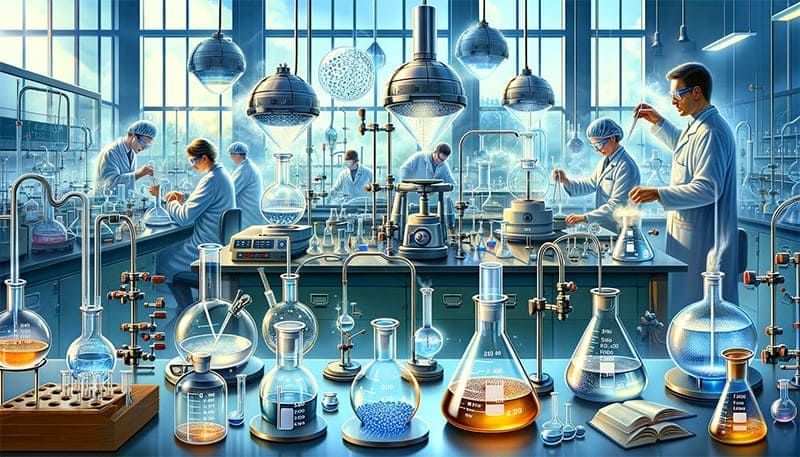
Practical Applications of Flasks in Laboratory Settings
Flasks are more than just glassware; they are vital instruments in a laboratory’s arsenal, used in a myriad of experiments and procedures. Their role in practical applications cannot be overstated. Here’s a closer look at how flasks are utilized in different laboratory scenarios:
Chemical Synthesis and Compound Preparation
- Reactions and Mixing: Erlenmeyer and round-bottom flasks are staples in chemical synthesis. Their shapes facilitate efficient mixing of reactants, crucial for promoting uniform reactions.
- Controlled Environment Creation: Three-neck flasks allow for the addition or removal of substances without disrupting the reaction environment, essential for sensitive synthesis processes.
Analytical and Quantitative Procedures
- Solution Preparation: Volumetric flasks are indispensable for preparing solutions with precise concentrations. Their accuracy is vital in quantitative analysis, where the concentration of reactants directly influences the experiment’s outcome.
- Titration Processes: Erlenmeyer flasks are commonly used in titrations for their wide base and narrow neck, which prevent spills during the swirling motion.
Sample Storage and Cultivation
- Culture Growth: In microbiology, flasks such as conical (Erlenmeyer) flasks are used to grow bacterial or cell cultures. Their shape allows for effective aeration and mixing of the culture medium.
- Long-term Storage: Certain flasks provide airtight environments for storing samples over extended periods, ensuring their integrity for future analysis.
Heating and Distillation Processes
- Even Heating: Round-bottom flasks are designed for uniform heating, making them ideal for procedures requiring consistent and gentle heat application, such as organic synthesis.
- Distillation: Specialized flasks like distillation flasks are used to separate liquid mixtures based on their boiling points, a fundamental process in both academic and industrial laboratories.
Filtration and Separation Techniques
- Vacuum Filtration: Büchner flasks are used in tandem with Büchner funnels for vacuum filtration, effectively separating solids from liquids in a mixture.
Custom Applications
- Specialized Research: Custom-designed flasks cater to unique experimental needs, such as extreme temperatures or pressure conditions, underscoring the adaptability of flasks in evolving scientific research.
By understanding and leveraging the specific applications of different types of flasks, scientists and researchers can significantly enhance the efficiency, accuracy, and safety of their laboratory work. These diverse applications of flasks underscore their indispensable role in the scientific world, making them more than just containers but rather essential tools in the pursuit of knowledge and discovery.
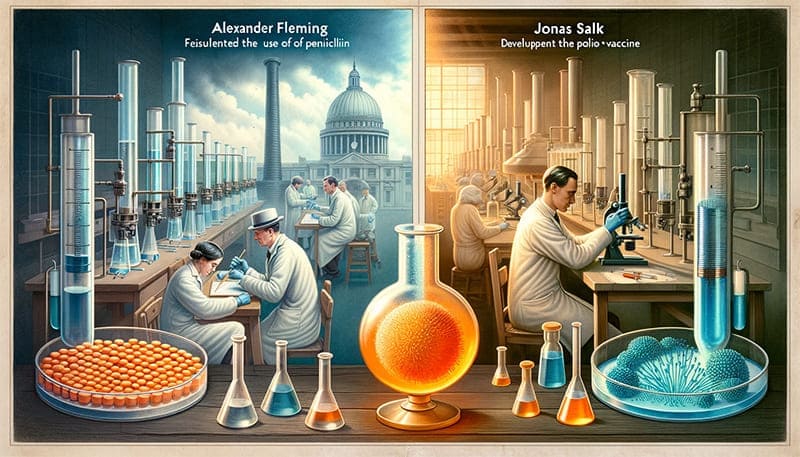
Case Studies and Real-World Applications
In this section, we explore two real-world scenarios where the choice and use of specific types of laboratory flasks were pivotal in achieving outstanding scientific results. These case studies not only underscore the practical applications of flasks but also highlight their critical role in scientific innovation.
Case Study 1: Discovery of Penicillin
Application: Alexander Fleming’s Pioneering Research
In 1928, Sir Alexander Fleming’s accidental discovery of penicillin marked a turning point in medical history. An essential component of his experiment was the use of Petri dishes and flasks. The controlled environment provided by these containers was crucial for cultivating the Penicillium mold and observing its antibacterial properties. This breakthrough, aided by the humble flask, led to the development of antibiotics, saving millions of lives.
Case Study 2: The Development of Polio Vaccine
Application: Jonas Salk’s Groundbreaking Experiment
In the early 1950s, Jonas Salk and his team, in their quest to develop a polio vaccine, relied heavily on flasks for culturing the poliovirus. The use of specialized flasks allowed for the safe and effective growth of the virus in a controlled environment, which was essential for developing the inactivated polio vaccine. This vaccine, developed through meticulous flask-based experiments, played a critical role in virtually eliminating polio in many parts of the world.
Conclusions Drawn from Historical Breakthroughs
From the case studies of Alexander Fleming’s discovery of penicillin and Jonas Salk’s development of the polio vaccine, we can draw several important conclusions:
- Critical Role of Laboratory Equipment: These examples highlight the indispensable role of laboratory flasks and other equipment in scientific discovery. The appropriate use of these tools was key to cultivating and studying the specific organisms involved.
- Impact of Controlled Environments: The ability to create and maintain controlled environments, as offered by laboratory flasks, is essential in experimental research. This control was crucial for the growth of Penicillium mold in Fleming’s work and the cultivation of the poliovirus in Salk’s vaccine development.
- Facilitation of Breakthrough Discoveries: Both case studies demonstrate how the correct use of laboratory flasks can facilitate groundbreaking scientific discoveries. These discoveries have had profound impacts on human health, showcasing the potential of well-conducted laboratory research.
- Bridge Between Simple Tools and Complex Outcomes: These stories exemplify how simple laboratory tools, like flasks, can be at the heart of complex and impactful scientific achievements. They remind us that innovation often relies on the effective application of basic tools and techniques.
- Inspiration for Future Research: The success stories of Fleming and Salk serve as inspiration for future scientific endeavors. They exemplify how dedication, along with the right laboratory equipment, can lead to significant advancements in various fields, especially in medicine.
The case studies of penicillin and the polio vaccine underscore the critical importance of selecting and utilizing appropriate laboratory equipment. They demonstrate that even the most common laboratory tools, like flasks, can lead to extraordinary scientific achievements with far-reaching implications.
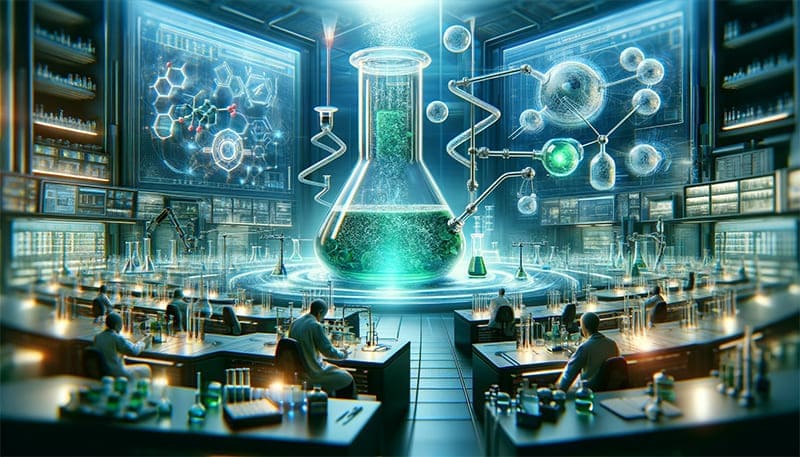
Achieving Brilliant Results Through Innovative Experiments with Flasks
In the pursuit of scientific excellence, the innovative use of laboratory flasks can be a game-changer. By exploring new ways to utilize these versatile tools, researchers can unlock a world of possibilities, leading to brilliant and groundbreaking results. Here’s how innovation in flask experiments can pave the way for remarkable discoveries:
Embracing Advanced Flask Technologies
- Smart Flask Integration: Incorporating smart flasks with built-in sensors can revolutionize experiments. These flasks can monitor real-time changes in temperature, pH, or chemical composition, providing precise control over experimental conditions.
- Automated Flask Systems: Utilizing automated systems for repetitive tasks like stirring or titration can increase accuracy and free up valuable research time for more complex tasks.
Creative Experimentation Techniques
- Custom Flask Modifications: Tailoring flasks to suit specific experimental needs, such as modified necks for unique distillation processes or specialized coatings for chemical resistance, can enhance the effectiveness of experiments.
- Hybrid Experimentation: Combining different types of flasks in a single experiment, such as using Erlenmeyer flasks for initial mixing and round-bottom flasks for subsequent heating, can optimize the experimental process.
Sustainable and Eco-Friendly Practices
- Green Chemistry with Flasks: Implementing green chemistry principles in flask experiments, like reducing waste and using non-toxic chemicals, can lead to more sustainable and environmentally friendly research.
- Recycling and Reusing Flasks: Encouraging the reuse and recycling of flasks reduces environmental impact and promotes sustainability in the lab.
Collaborative and Interdisciplinary Approaches
- Cross-Disciplinary Experiments: Combining knowledge from different scientific fields in flask experiments can lead to innovative approaches and solutions to complex problems.
- Collaborative Research Projects: Engaging in collaborative experiments with other labs and institutions can bring in fresh perspectives and expertise, enhancing the potential for significant discoveries.
Education and Training
- Training in Advanced Flask Techniques: Providing education and training on the latest flask technologies and experimental methods can empower new generations of scientists to conduct more advanced and innovative research.
Continuous Learning and Adaptation
- Keeping Up with Scientific Advances: Staying informed about the latest developments in flask technology and experimental techniques is crucial for continually improving and innovating laboratory practices.
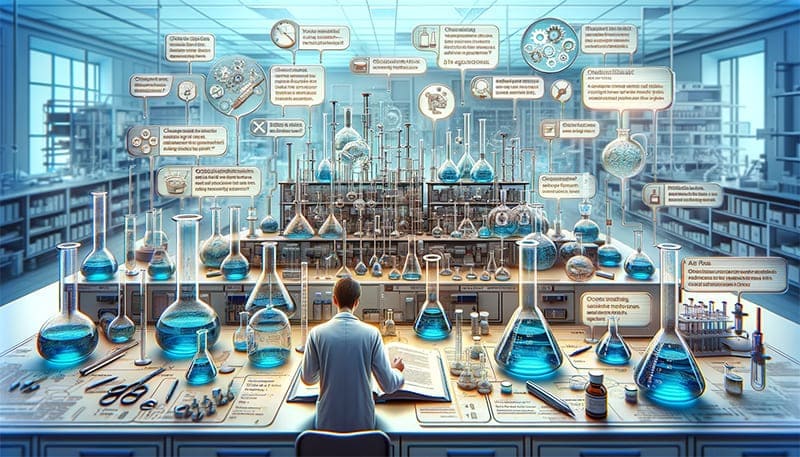
Frequently Asked Questions and Quick Tips for Flask Usage
Navigating the world of laboratory flasks can be as complex as the experiments they are used in. To help you master this essential lab tool, we’ve compiled a list of frequently asked questions and quick tips. This section aims to provide you with practical advice and answers to common queries, ensuring you’re well-prepared for your scientific endeavors.
Frequently Asked Questions
Q1: What is the main difference between an Erlenmeyer flask and a round-bottom flask?
- A1: An Erlenmeyer flask has a conical shape with a flat bottom, making it stable and ideal for mixing by swirling. A round-bottom flask has a spherical bottom, suitable for even heating and is often used in distillation processes.
Q2: How do I choose the right flask for my experiment?
- A2: Consider the nature of your experiment. For precise measurements, choose volumetric flasks. For heating and reactions, round-bottom or three-neck flasks are ideal. For mixing and titrations, Erlenmeyer flasks are preferred.
Q3: Can flasks be reused for different experiments?
- A3: Yes, but ensure they are thoroughly cleaned and sterilized to avoid cross-contamination. Different experiments might require different levels of cleanliness.
Quick Tips
- Regular Inspection: Regularly inspect your flasks for any cracks or damage, especially those used under high temperatures or pressure.
- Proper Storage: Store flasks in a way that prevents damage, such as in specialized racks or cabinets, and ensure they’re easily accessible.
- Label Appropriately: Always label your flasks to avoid mix-ups, especially when dealing with multiple chemicals or solutions.
- Use for Intended Purpose: Use flasks according to their designed purpose. For example, don’t use a volumetric flask for boiling liquids, as it’s meant for precise measurements.
- Temperature Awareness: Be aware of the temperature limits of your flasks, particularly when dealing with extreme heat or cold.
- Disposal: Dispose of broken or damaged flasks safely and responsibly, following your lab’s guidelines.
In summary, understanding the intricacies of laboratory flasks is key to successful experiments. Whether you’re a seasoned scientist or a budding researcher, these FAQs and quick tips are designed to enhance your knowledge and ease your lab work. Remember, the right flask can be the difference between an ordinary experiment and a groundbreaking discovery. Embrace the power of knowledge and let your scientific journey flourish!
Conclusion
In conclusion, “The Ultimate Flask Guide” is more than just a manual; it’s a gateway to transforming laboratory practices. As you venture into the world of scientific exploration, remember that the humble flask is your ally in navigating the complexities of research. Embrace innovation, practice sustainability, and keep pushing the boundaries of discovery. For more insights and an extensive range of flask options to equip your lab for excellence, visit Glasswaree Laboratory Flasks. Let your journey to brilliant results begin today!


